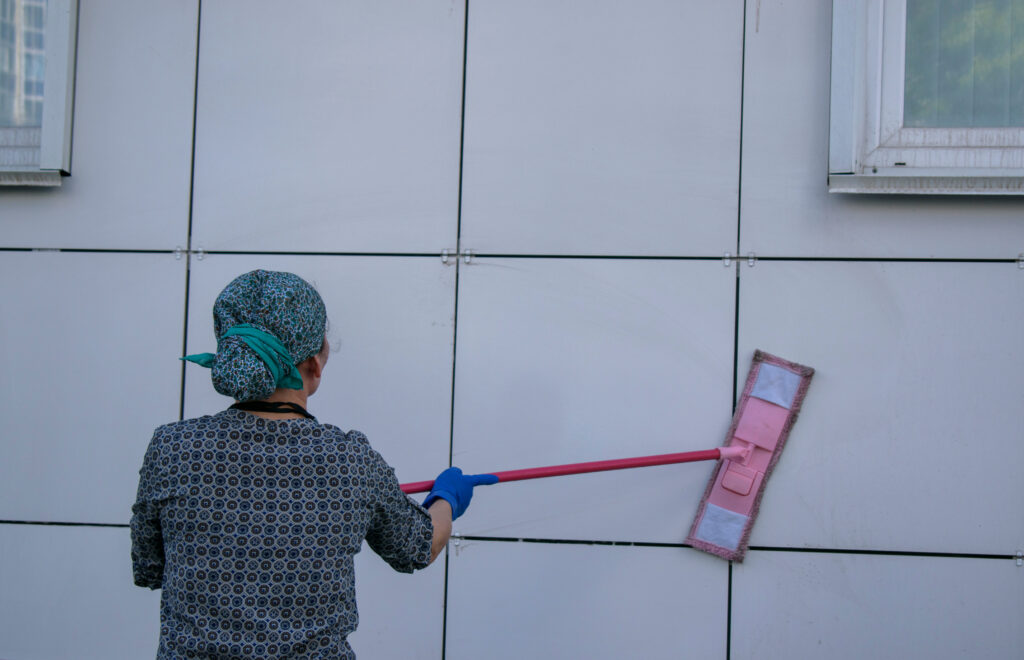The façade is one of the most important elements on a building, not just for its internal aspect, but also because its quality and installation determine the well-being of its visitors. Over the years, its thickness has been considerably reduced and its cladding has been improved to the point that techniques have been achieved that can obtain maximum energy efficiency, like the ventilated façade.
In light of what has just been said, it is easy to assume, therefore, how cleaning a ventilated façade plays a key role: the fact that it is the external façade on a building means that it is exposed to the effects of weather or external events that could cause serious problems if not dealt with in time. These problems do not just relate to those living in the building, but can also pose a risk to those walking below in the street with, for example, collapsing, cracks, falling pieces and so on.
Given that the ventilated façade in porcelain stoneware is our speciality, we would like to share a few guidelines with you on how to clean porcelain stoneware outside, so that you know how to keep your ventilated façade in excellent condition.
However, before we show you how to clean porcelain stoneware externally, we would like to highlight that ventilated façades require very little maintenance because the cladding slabs prevent any kind of infiltration of stains and guarantee that the material is kept in good condition.
Furthermore, even before taking a closer look, we would like to point out how, generally speaking, a few technical times need to be respected when cleaning a ventilated façade:
- Every 3 years: check the state of the cladding and verify the condition of the individual points (corners, crowns, awnings etc.);
- Every 5 years: check for the presence of cracks, splits or collapsing;
- Every 10 years: check the cleaning state of the ventilation openings in the chamber.
Basically, it is essential to understand how proper maintenance and protection of the façades can preserve them over time, having a considerable effect both on the building’s appearance and surrounding area, and the economic resources of the property.
Lastly, we believe that it is extremely important to bring to your attention that the Financial Statement for 2021 has extended the so called Façade Bonus until 31 December 2021, that is, the 90% tax deduction to renovate façades on existing buildings. The tax benefit also includes cleaning a ventilated façade or its external painting, or all the work aimed at renovating or restoring the opaque structures on a façade, including balconies, ornaments and decorations.

How to clean porcelain stoneware externally: a few simple tips on how to preserve the original appearance over time.
Porcelain stoneware is a mix of raw materials whose composition is not far removed from Vitreous China (the kind of porcelain most commonly used in the bathroom fixture ceramic, because the resistance and water-tightness of the raw piece is decidedly greater than other two kinds of material, that is, fine porcelain stoneware, fine fire clay and the porcelain stoneware, fire clay, thanks to the high percentage of vitreous phase). This is a completely waterproof material with excellent mechanical features. The term porcelain – highlighting the sophisticated elegance of the stoneware – derives from the use of kaolin, a kind of white clay also used in the production of Bone China (high quality porcelain made with bone ash).
Clays and quality feldspars, exposed to a high temperature baking process, transform the stoneware into tiles with the following features:
- Chemical and freezing resistance;
- Resistance to collision;
- Durable against scratching.
In order to remove the dirt from grease and smog as well as the remains of various deposits from porcelain stoneware externally, an alkaline based cleaning product needs to be used.
In order to clean the ventilated façade thoroughly – for the most obstinate dirt from smog and remains of deposits, in other words – an acid based cleaning product needs to be used: its formula does not corrode noble metals nor does it damage glass. The product needs to be diluted in water and applied using a brush, roller or spray then removed with a cleaning machine.



